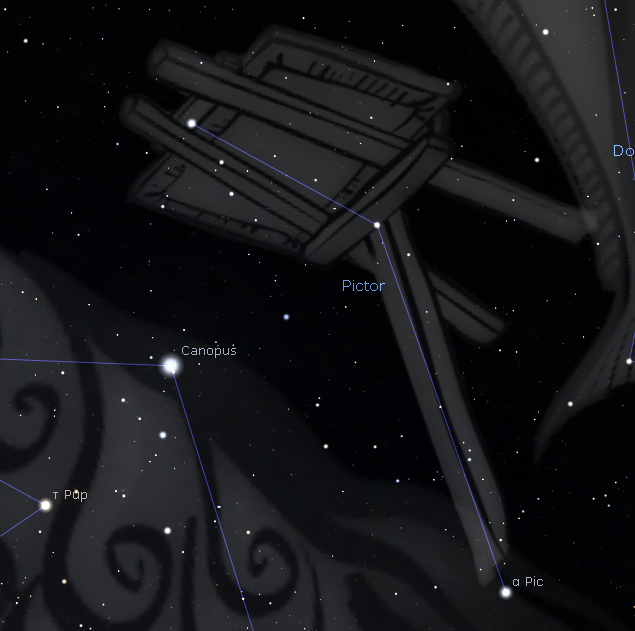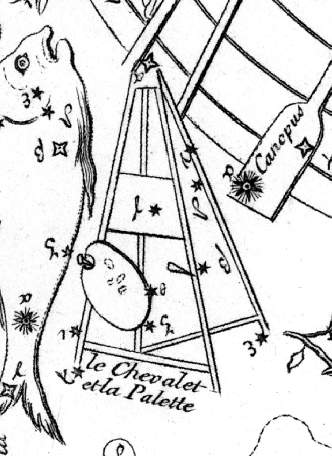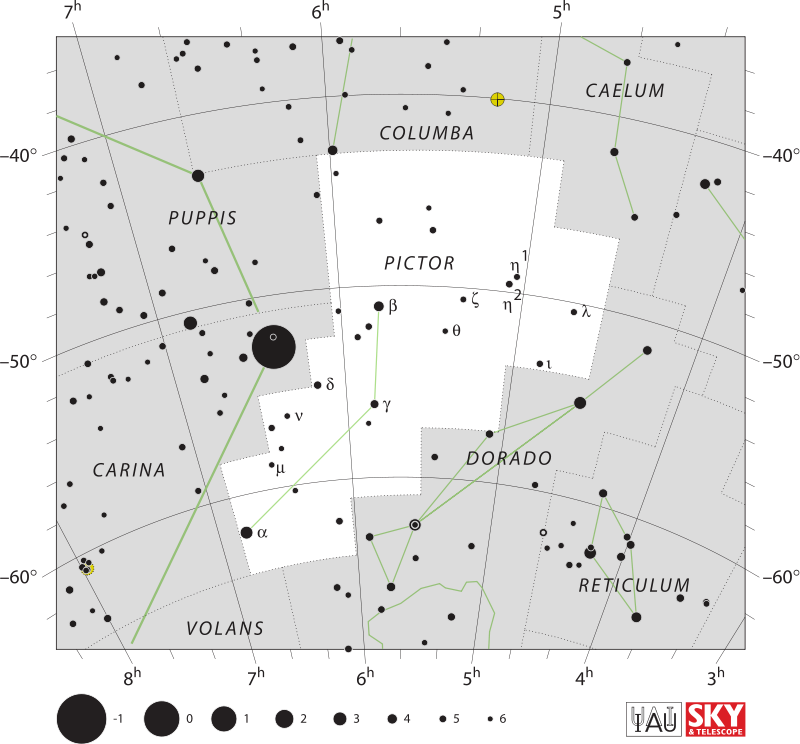|
Between the star Canopus and the Large Magellanic Cloud, in the Southern Celestial Hemisphere, is the constellation Pictor. Its name, which is an acronym of the previous term Equuleus Pictoris (the "painting's easel"), is Latin for a painter. Pictor, who is typically depicted as an easel, was given that name in the 18th century by Abbé Nicolas-Louis de Lacaille. Alpha Pictoris, a white main-sequence star located ninety-seven light-years from Earth, is the brightest star in the constellation. Additionally, Pictor is home to RR Pictoris, a catastrophic variable star system that burst into existence in 1925 as a nova and rose to an apparent (visual) brightness of 1.25 before going dim.
Beta Pictoris, Pictor's second-brightest star, which is 63.4 light-years from Earth and is encircled by an unusual dust disc rich in carbon as well as an exoplanet, has drawn interest (extrasolar planet). There have been reports of five additional stars in the constellation having planets. A prospective super-Earth in the circumstellar habitable zone is HD 40307, an orange dwarf with six planets around it. HD 40307 g is one of these planets. The red dwarf Kapteyn's Star, the Pictor star closest to Earth, is 12.76 light-years away and has two super-Earths orbiting it as of 2014. A supermassive black hole at the centre of the radio galaxy Pictor A is producing an 800,000 light-year-long jet of plasma. |
|
History
Pictor was first named le Chevalet et la Palette (the easel and palette) by the French astronomer Abbé Nicolas-Louis de Lacaille in 1756 when he observed and recorded 10,000 southern stars during a two-year sojourn near the Cape of Good Hope. In unexplored areas of the Southern Celestial Hemisphere that were obscured from Europe, he created fourteen new constellations. All but one of them recognised the tools of the Age of Enlightenment. (Wagman 2003) He assigned Bayer names to several constellations, including ten stars in Pictor that is today known as Alpha through Nu Pictoris. On his 1763 chart, he labelled the constellation Equuleus Pictorius (Wagman 2007), with the word "Equuleus" denoting a small horse or easel, possibly about an earlier practice among artists of transporting a canvas on a donkey. (Chartrand 1982) Pluteum Pictoris is what German astronomer Johann Bode termed it. Francis Baily, an English astronomer, reduced the name to its present form in 1845 at Sir John Herschel's suggestion. |
Characteristics
Columba to the north, Puppis and Carina to the east, Caelum to the northwest, Dorado to the southwest, and Volans to the south border the little constellation Pictor. The International Astronomical Union chose the three-letter abbreviation "Pic" for the constellation in 1922. (Russell 1922) A polygon with 18 segments serves as the official constellation borders, which Belgian astronomer Eugène Delporte established in 1930. These borders' right ascension values in the equatorial coordinate system range from 04h 32.5m to 06h 52.0m, while their declination coordinates fall between 42.79° and 64.15°. Every year on March 17 at 9:00 p.m., Pictor concludes. The entirety of the constellation is visible because of its location in the extreme southern celestial hemisphere.
Columba to the north, Puppis and Carina to the east, Caelum to the northwest, Dorado to the southwest, and Volans to the south border the little constellation Pictor. The International Astronomical Union chose the three-letter abbreviation "Pic" for the constellation in 1922. (Russell 1922) A polygon with 18 segments serves as the official constellation borders, which Belgian astronomer Eugène Delporte established in 1930. These borders' right ascension values in the equatorial coordinate system range from 04h 32.5m to 06h 52.0m, while their declination coordinates fall between 42.79° and 64.15°. Every year on March 17 at 9:00 p.m., Pictor concludes. The entirety of the constellation is visible because of its location in the extreme southern celestial hemisphere.
Deep-sky Objects
Pictor is situated in a quiet part of space and of the galactic plane. This area has near enough no DSO objects.
Main stars - 3
Bayer stars - 15
Stars with planets - 6
Stars brighter than Magnitude 3.00 - 0
Stars within 32 Ly - 1
Messier objects - 0
Meteor showers - 0
Bordering
constellations
Pictor is situated in a quiet part of space and of the galactic plane. This area has near enough no DSO objects.
Main stars - 3
Bayer stars - 15
Stars with planets - 6
Stars brighter than Magnitude 3.00 - 0
Stars within 32 Ly - 1
Messier objects - 0
Meteor showers - 0
Bordering
constellations
- Caelum
- Carina
- Columba
- Dorado
- Puppis
- Volans


